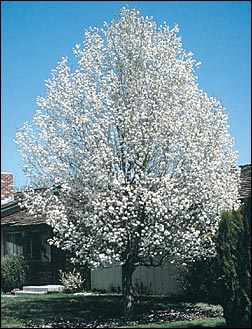
Both fruiting and non-fruiting pears have proven themselves worthy of consideration for this area. They are tolerant of cold, wind, heat, drought and poor soils. Plant in full sun, well-drained soils and water once every 7-10 days. This deciduous tree is not temperature sensitive or prone to disease, and does not need protection. This tree is good for planting along streets.
- P. calleryana (Flowering Pear) 40 ft. tall by 30 ft. wide; white flowers in May; red, orange and yellow fall colors
- P. communis (Fruiting Pear) 15-30 ft. tall by 15-30 ft. wide; white flowers; edible fruits from August-October; fall color depends on variety
- P. calleryana (Bradford) Profuse white flowers bloom in spring on this rounded tree that grows 35 ft. tall and 30 ft. wide. Fall colors begin in the yellows and turn red as the season ends.
- P. calleryana (Capital) A tree that lends itself to narrow areas with all of the qualities of the other fruitless pears. The flowers are white and fall colors are reddish. Drought tolerance is good as well as insect and disease resistance. Good for sidewalks.
- P. calleryana (Redspire Pear) A very formal appearing tree with a tight branch habit and symmetrical shape. Very drought tolerant, works well in median strips where temperatures change drastically. Leaves are medium green and glossy, with fall colors range from bright yellow to red. Profuse white flowers in spring.
